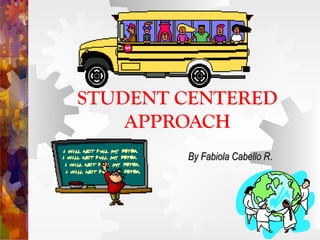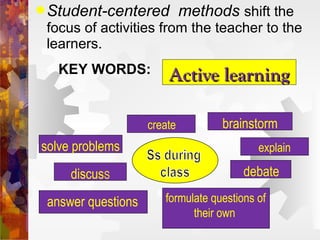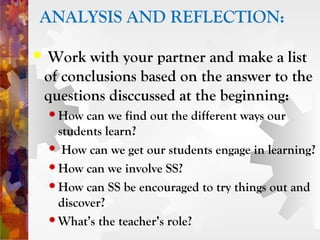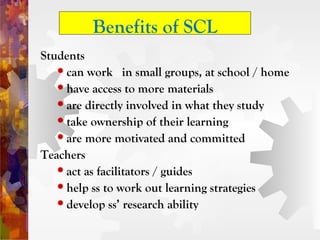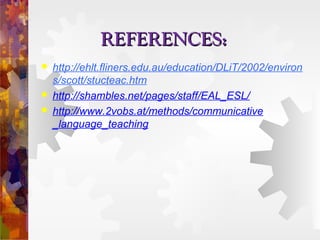Student centered learning
- 1. STUDENT CENTERED APPROACH By Fabiola Cabello R. R
- 2. BELIEFS ABOUT LEARNING ’é« Students learn in different ways
- 3. BELIEFS ABOUT LEARNING ’é«Learningis an active dynamic process
- 4. BELIEFS ABOUT LEARNING ’é« Students respond well when they are involved
- 5. BELIEFS ABOUT LEARNING ’é«Ss learn with guidance, not prescriptions
- 6. BELIEFS ABOUT LEARNING ’é« Knowledge is internal;Ss build it
- 7. By the end of this workshop we will all be able to provide the answers to the questions previously raised
- 8. WORK IN PAIRS: ’üČ Watch the demo classes and take notes of the characteristics of each one. ’é«Discuss the insights with your peers
- 9. COMPARE THIS PICTURE TO THE TWO CLASSES YOU HAVE JUST WATCHED ┬Ā
- 10. DISCUSS IN PAIRS: In your classŌĆ” ’é« Who produces more? ’é« You, as a teacher orŌĆ”. ’é« your students?
- 11. OLD TRADITIONAL APPROACH: ’é« Most class time is spent with the teacher lecturing and the students watching and listening.
- 12. ’é« Students work individually on assignments, and cooperation is discouraged. ’é« Activities have no meaningful purpose.
- 13. WE CAN GET THIS RESULT: ’é« OrŌĆ” maybe this one!
- 14. ’é« Student-centered methods shift the focus of activities from the teacher to the learners. KEY WORDS: Active learning create brainstorm solve problems explain discusS debate answer questions formulate questions of their own
- 15. MAIN CHARACTERISTICS OF A STUDENT CENTERED CLASS ’é«Ss are active doers: Ss own 80% of the lesson ’é« Teachers are organizers: Little time on TTT (20% of the lesson)
- 16. ’ā╝ A Checklist we should meet in order to achieve a SCL: When thinking about activities and tasks to include in our LPsŌĆ”
- 17. ’ā╝ A Checklist for meeting a SCL: The activity or task must containŌĆ” ┬Ā ’ā╝Prediction ’ā╝Self-discovery ’ā╝Lesson involvement ’ā╝Knowledge application ’ā╝Varied SsŌĆÖ interaction patterns
- 18. WE CAN achieve this checklist through different kinds of activities: GAMES/SONGS WITH LEARNING VALUE TASKS ACTIVITIES WITH VARIED INTERACTION PATTERNS
- 19. KEEP IN MIND ŌĆ” ŌĆØAll of the tasks and activities that teachers prepare must facilitate a positive and effective learning environment.ŌĆØ environment.
- 22. ŌĆ£ PRESENT A SC ACTIVITY: ’é« Using a page of your book demonstrate a SC activity. ’é« Take into consideration the checklist and characteristics mentioned: ’ā╝ Prediction ’ā╝ Self-discovery ’ā╝ Lesson involvement ’ā╝ Knowledge application ’ā╝ Varied SsŌĆÖ interaction patterns
- 23. NOW WE ARE STUDENTS ’é«
- 24. TCL vs. SCL S3 S1 S2
- 25. ANALYSIS AND REFLECTION: ’é« Work with your partner and make a list of conclusions based on the answer to the questions disccussed at the beginning: ’é« How can we find out the different ways our students learn? ’é« How can we get our students engage in learning? ’é« How can we involve SS? ’é« How can SS be encouraged to try things out and discover? ’é« WhatŌĆÖs the teacherŌĆÖs role?
- 26. Benefits of SCL Students ’é« can work in small groups, at school / home ’é« have access to more materials ’é« are directly involved in what they study ’é« take ownership of their learning ’é« are more motivated and committed Teachers ’é« act as facilitators / guides ’é« help ss to work out learning strategies ’é« develop ssŌĆÖ research ability
- 27. A good teacher is one who makes himself progressively unnecessary. ~Thomas Carruthers
- 29. REFERENCES: ’é« http://ehlt.fliners.edu.au/education/DLiT/2002/environ s/scott/stucteac.htm ’é« http://shambles.net/pages/staff/EAL_ESL/ ’é« http://www.2vobs.at/methods/communicative _language_teaching
Editor's Notes
- #3: Have Teachers work in pairs and support each of the beliefs regarding ESL with an example
- #4: Have Teachers work in pairs and support each of the beliefs regarding ESL with an example
- #5: Have Teachers work in pairs and support each of the beliefs regarding ESL with an example
- #6: Have Teachers work in pairs and support each of the beliefs regarding ESL with an example
- #7: Have Teachers work in pairs and support each of the beliefs regarding ESL with an example
- #10: Metaphore : Ts are to compare this picture to the demo classes. WhoŌĆÖs the director? Who are the musicians? WhatŌĆÖs the role of the director of the orchestra? WhatŌĆÖs the role of the musicians?
- #26: Go back to slides 2-3-4-5-

